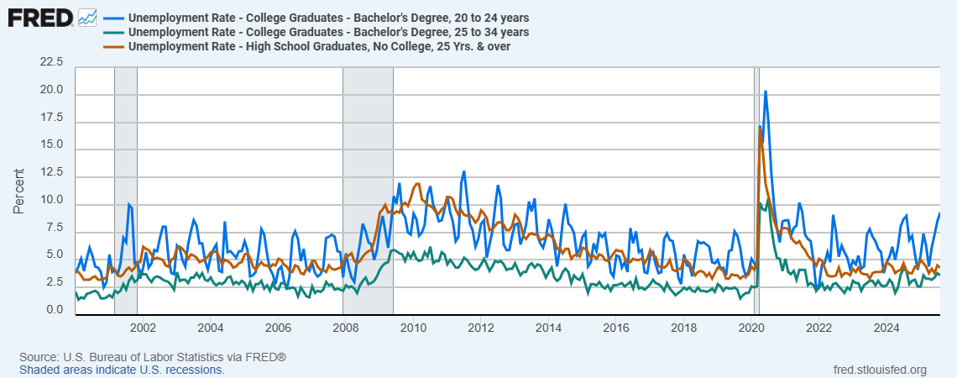U.S. job market dynamics have changed drastically over the last few years. At least on the surface. But they suggest things have been deteriorating over decades.
Recent College Grads Face High Unemployment
The newest sign of economic development is the unemployment rates of three different groups: 20 to 24-year-old holders of bachelor’s degrees, 25 to 34-year-old holders of bachelor’s degrees, and 25-plus-year-old high school graduates with no college.
From the usual assumptions people develop about education and employment, you might expect older college graduates to be further in their careers with the lowest unemployment rates, new graduates with somewhat higher unemployment, as they’re still establishing themselves, and those with only a high school education with the highest unemployment rates.
The following graph from the Federal Reserve Bank of St. Louis, using the latest pre-shutdown data from the U.S. Bureau of Labor Statistics, shows different patterns.
The green line represents the unemployment rate of 25 to 30-year-old holders of bachelor’s degrees. The blue line is for new college graduates. The red line shows high school graduates with no college.
The August numbers show that the 25-to-34 college graduates had the lowest unemployment rate of the three: 3.6%. The next lowest is the high school graduates at 4.3%, or the same as the overall national average. New college graduates had an unemployment rate of 9.3%, about 2.5 times larger than the more established bachelor’s degree holders.
Since 2000, new graduate unemployment rates have always been volatile. However, before the pandemic, new grads and high school-only graduates were more similar, with the latter acting almost like a trendline for the former.
That changed. After the pandemic, new grad unemployment was the highest of the three. High school grads hovered around the national average. The distance between high school graduates and college grads with more experience has shrunk. The natural advantage that many go into college expected to absorb seems gone.
Other Signs
Maybe the new graduates are taking time off, assuming they’ll get a job in time. Maybe many can’t find work, at least in their field.
Data from 2023 analyzed by the Federal Reserve Bank of New York showed that when unemployment is considered by college majors, some of the top ten with the highest rates — physics (7.8%), computer engineering (7.5%), computer science (6.1%), chemistry (6.1%), and information systems & management — are in science, technology, engineering, and mathematics, or STEM, studies typically considered “safe” for careers.
There is no way to know how many of the people worked in the fields in which they earned a degree. For example, an old 2013 survey from CareerBuilder said that 47% of college-educated workers said their first job after college wasn’t related to their major; 32% said they never found a job related to their major. Coming after the Global Financial Crisis, those figures could be unrepresentative for “normal” times.
However, there seem to be changes in the waters. There’s been another shift in jobs data. Periods of growing lengths of unemployment — the percentage of people out of work for at least 27 weeks — since 1948 have always occurred right after a recession. The latest upswing, though, started in mid-2023, for the first time without a recession.
These are all data points suggesting that something is happening in the economy that we haven’t seen before. If you’re getting nervous about where things seem to be heading, it’s understandable.

